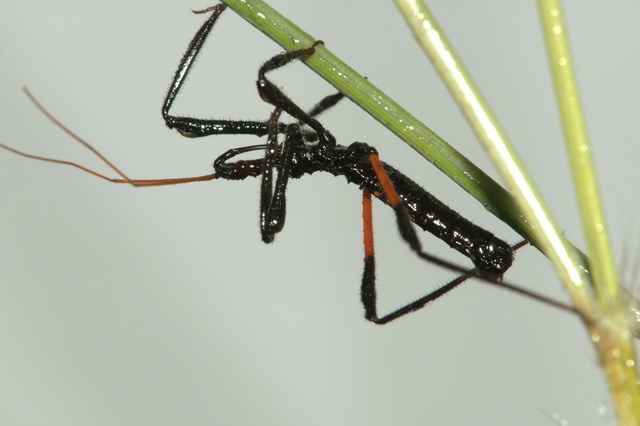Gorareduvius assassin bug is covered in resin
A Gorareduvius assassin bug uses resin as a tool to overpower prey. That works fine, as Fernando Soley and Marie Herberstein show.
Assassin bugs prey on insects; they grasp them with their forelegs, stab them with their proboscis and suck them out. Insects that are trapped try to escape, of course, but some species of assassin bugs impede that. They coat their body with sticky resin so that prey items cannot escape so quickly.
One of these resin users is an otherwise poorly known Gorareduvius species. It is successful with its sticky strategy, as Fernando Soley and Marie Herberstein show.
Meticulously applied
Gorareduvius lives in Western Australia, where it resides in hummocks of curly spinifex grass, which produces resin. The assassin bug scrapes resin off the grass leaves and applies it meticulously to its body, particularly onto its forelegs. Every individual does it, a Gorareduvius assassin bug is always sticky.
Soley and Herberstein conducted experiments in which they staged interactions between this assassin bug and two types of fast-moving prey: ants and flies. In some trials the assassin bug was allowed to keep its resin equipment, in other cases the researchers gently removed it.
Equipped with resin, Gorareduvius more successfully captures ants and flies, as it turned out. The prey can still escape, but the resin stops them for a while, giving the assassin bug more chance to stab them. As a result, capture attempts of resin-equipped assassin bugs are more often successful than those of clean assassin bugs.
Tool
The assassin bug family (Reduviidae) contains about 7000 species. Part of these species cover themselves in resin to enhance prey capture, which the researchers consider as tool use. The habit has arisen at least three times independently.
Willy van Strien
Photo: Gorareduvius, an assassin bug; on the forelegs, above the nod, you see small lumps of resin and where the antennae branch you see the large proboscis. ©Fernando Soley
Sources:
Soley, F.G. & M.E. Herberstein, 2023. Assassin bugs enhance prey capture with a sticky resin. Biology Letters 19: 20220608. Doi: 10.1098/rsbl.2022.0608
Zhang, J., C. Weirauch, G. Zhang & D. Forero, 2016. Molecular phylogeny of Harpactorinae and Bactrodinae uncovers complex evolution of sticky trap predation in assassin bugs (Heteroptera: Reduviidae). Cladistics 32: 538-554. Doi: 10.1111/cla.12140
